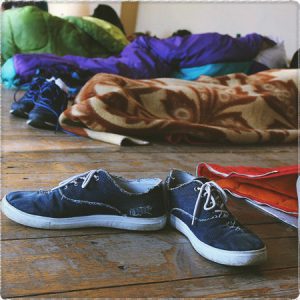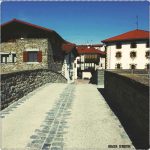SWEET DREAMS
 There is much debate whether you need a sleeping bag or a liner during the summer on the Camino de Santiago. To say the truth there is no such thing as a specific Camino sleeping bag. The only right one is the one that’s right for you, your chosen route, the time of year and the way you want to do it.
There is much debate whether you need a sleeping bag or a liner during the summer on the Camino de Santiago. To say the truth there is no such thing as a specific Camino sleeping bag. The only right one is the one that’s right for you, your chosen route, the time of year and the way you want to do it.
In other words you have to ask yourself if you normally sleep warm or cold, if you intend to sleep in it every night or just now and again, what is your weight to warmth tolerance…etc
But let’s see some of the options we have here…
Sleeping Bags
There are two main shapes used for sleeping bag; the mummy and the rectangle, (there are some slight variations on these). In colder weather the mummy bag is certainly the best as it is designed with maximum thermal efficiency, they are also usually lighter due to being slightly smaller – an important consideration on the Camino de Santiago where you want to keep your backpack as light as possible.
The rectangle sleeping is a very good option.Mummy bags may be too restrictive while sleeping or trying to get to sleep – though after walking all day falling asleep will never be an issue. Normally these bag can open up and be used as a blanket or like a duvet. (For couples walking the Camino you can also buy rectangle bags that zip two bags together)
Each of the sleeping bags types can have various extra features like a hood, a tape that covers the zip for better insulation, a stash pocket, and even loops to hold a sleeping mat – though you will not need a sleeping mat on the Camino.
Synthetic and Down Sleeping Bags.
Down sleeping bag have two type of construction: box baffle and sewn through.
The Box Baffle construction is simply bags sewn between in outer shell and the inner liner. Sewn Through bags stitch the shell and liner together. The box method leaves no possible cold spots on the sleeping bag, where that can happen in sewn through bags.
A down Sleeping Bag is lighter, can last up to 25 years, don’t lose their thermal efficiency over time and it’s easy to compress. But take longer to dry; (they are water resistant not waterproof), can smell, (usually the duck down), are more expensive, can be allergenic.
Synthetic bags have two common constructions; layered and shingles.
Layered bags often have two separate sheets; one is stitched to the shell the other to the liner. Shingle bags are like roof tiles where the cut pieces of fabric overlap within the shell and liner. Both types are as good as each other.
The shell in both types of bag are usually made from nylon or polyester with some sort of waterproof treatment – cheaper sleeping bags are treated with a water repellent which helps stop water seep into the bag. More expensive bags have a breathable waterproof shell, which is considerable more expensive.
Sleeping bag linings are made from nylon and polyester which are comfortable and let body moisture evaporate.
Temperature Rating
Within the EU there is a legal standard for the thermal efficiency of sleeping bags to ensure all manufacturers adhere to a common standard. In the US there is no legal regulation, but many manufacturers and suppliers, including REI, have started using the European EN13537 temperature rating guide. However, this is still a little opaque, as tests assume the person is sleeping on a mat and wearing full length underwear. It is also worth noting, as any married person will know, that women sleep with a slightly colder body temperature than men – and almost all bags are tested to suit men.
This problem with rating is only an issue if you are sleeping outside in freezing weather. Most sleeping bags fall into the following categories: summer, two season, and winter. Use your time of year on the Camino as the guide, bear in mind you will likely never sleep outside – though in the winter you may be sleeping in an unheated hostel.
Liner Instead of a Sleeping Bag
From the middle of June to about the end of August a sleeping bag liner could be enough on the Camino. There are some parts of the Camino Frances which are mountainous and can be chilly, so either bank on blankets being available or take a fleece blanket which is very light. (A survival blanket is also a possibility – they are also very light) Though you will be carrying the blanket for 30+ days to use on only two nights. Liners come in cotton or silk; the silk ones are better quality and more comfortable against skin.
The choice is yours. Know your own needs and pick out the sleeping bag that really fits you. Ask for advice in specialised shops or to other experienced pilgrims before you make up your mind. And remember that there is no a perfect solution that suits everybody. You have to find the right one for yourself.
By somewhereslowly/ caminoadventures Image: Pixabay.



